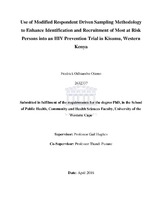| dc.description.abstract | This thesis presents research on the use of modified respondent driven sampling (mRDS) methodology to enhance identification and recruitment of key populations (KP) into an HIV prevention trial in Kisumu, western Kenya through a three phase mixed method study. The study was carried out in Kisumu, western Kenya within the Kenya Medical Research Institute (KEMRI) and the US Centers for Disease Control and Prevention (CDC) Research and Public Health Collaboration platform. The three phases included: 1. PHASE I: Identification and determination of categories of KPs and techniques of locating and motivating them to participate in HIV prevention trials.2. PHASE II: Design and Implementation of a mRDS methodology in recruiting Ks into HIV prevention trials.3. PHASE III: Evaluation of the mRDS in recruitment of KPs into an HIV incidence cohort study. Methods Phase I of the study included the conduct of in depth interviews which were used to identify different categories of persons considered to be KPs within Kisumu, identify strategies of locating the KPs and determine motivators and inhibitors of KPs participation in HIV prevention trials. Phase II on the other hand included the administration of a survey that had been refined in Phase I. The survey was used to design a mRDS methodology which was then implemented to recruit KPs into the survey. Phase III evaluated the success of the mRDS in recruiting KPs into an HIV prevention study by assessing the risk profiles for participants screened and enrolled into the Phase III study. Ethical approval for the study was sought from the ethics committee of the Kenya Medical Research Institute, the US CDC and the University of the Western Cape.The study recruited 53 individuals into phase I and was able to 8 identify different categories of people considered to be KPs and the 4 salient strategies that could be used to recruit them into HIV prevention studies. The phase also identified 8 potential motivators and 9 potential inhibitors to participation in HIV prevention research. These categories and salient strategies were used in phase II to develop and pilot a mRDS methodology in recruiting 203 individuals into a survey. The survey was used as a validation tool for the risk levels of persons recruited by the mRDS using the variables of inconsistent condom use and having multiple partners. The validated mRDS was then applied in the recruitment of 1,292 participants in phase III of thestudy. These study participants had characteristics similar to those seen in similar studies and elucidated from phases I and II of the study. HIV seropositivity was used as the variable for validating risk levels of participants in this study and this was found to be higher that that seen in general population and comparable to that seen in other KPs groups in the region. Results: Overall the study was able to identify different categories of people considered to be at high riskof HIV acquisition. The groups identified included people who frequent bars (e.g. bar workers, drunkards, sex workers, businessmen), people who work in transportation (e.g. truck drivers, matatu drivers, motorcycle drivers, taxi drivers, bicycle taxi drivers), fishermen/fishmongers, MSM and hair salon workers. The study also identified using personal contact, link persons, peer mobilisers and leaders as strategies of identifying and locating KPs. The study used the mRDS successfully in recruiting participants with evaluation of inconsistent condom use and multiple sexual partnerships showing the participants to be of high risk behaviour. Of all the females in the study, only 3.3% were pregnant. The prevalence of Chlamydia was 2.9%, gonorrhoea was 5.0%, syphilis was 0.4% and HSV-2 was 46.0%. Those who tested positive for HIV were 26.2% with 42.3% of the HIV positive participants having CD4 counts of between 250 – 500 cells/ml. Recommendations and Conclusion:The mRDS was successful in recruiting KPs in an HIV prevention trial. Majority of the participants reported inconsistent condom use and having multiple sex partners. In addition to MSM, SW and transport industry workers, fisherfolk, discordant couples, widowers, street youth, car washers and police also form part of KPs groups. The HIV prevalence was higher amongst these groups compared to general population with discordant couples having the highest HIV prevalence. The study recommends that mRDS should be used to identify and recruit KPs as it not only allows for faster recruitment of KPs, it also reduces the expense and complexity associated with coupon management in the standard RDS. | en_US |

